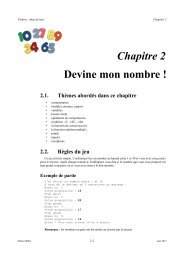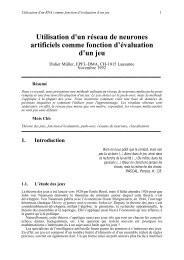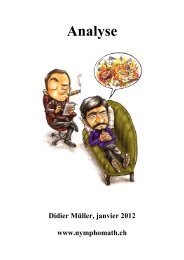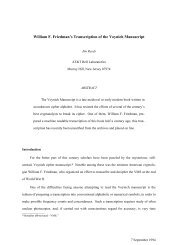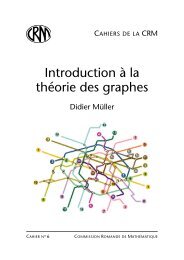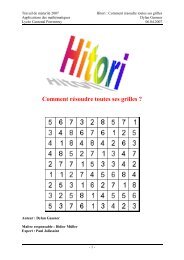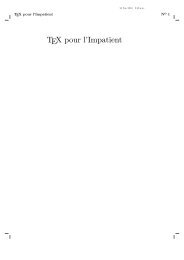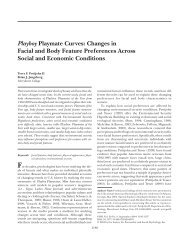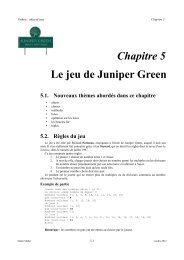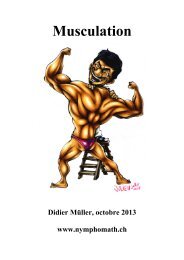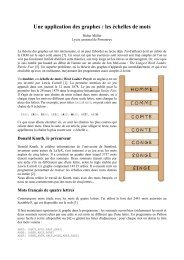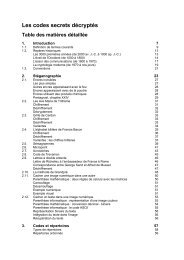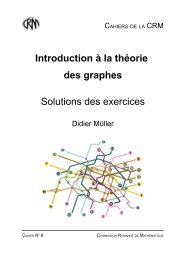<strong>Une</strong> <strong>petite</strong> <strong>histoire</strong> <strong>de</strong> <strong>l'informatique</strong>1801Joseph Marie Jacquard (1752-1834) inv<strong>en</strong>te <strong>de</strong>s cartes pour comman<strong>de</strong>r le tissage <strong>de</strong> motifs surles métiers à tisser. On peut considérer cette inv<strong>en</strong>tion comme le début <strong>de</strong> la programmation.1823Charles Babbage (1791-1871) comm<strong>en</strong>ce à construire sa machine à différ<strong>en</strong>ces, inspiré par lemétier à tisser <strong>de</strong> Jacquard.Babbage caresse l'idée <strong>de</strong> cette machine <strong>de</strong>puis 1812. Il s'adjoint l'ai<strong>de</strong> d'une jeune femme, AdaLovelace (1815-1852), brillante mathématici<strong>en</strong>ne qui l'ai<strong>de</strong> à concevoir les « diagrammes » pourfaire fonctionner la machine. Il semblerait que c'est Lady Ada qui conçoit le premier langageinformatique pour la machine à différ<strong>en</strong>ces <strong>de</strong> Babbage (elle donnera d'ailleurs son nom au langage<strong>de</strong> programmation Ada), mais d'autres biographes p<strong>en</strong>s<strong>en</strong>t qu'elle a seulem<strong>en</strong>t corrigé une erreur <strong>de</strong>Babbage.Dans une correspondance avec Sir Humphry Davy <strong>en</strong> 1822, Babbage y discute <strong>de</strong> certainesapplications d'une telle machine, notamm<strong>en</strong>t pour le calcul et l'impression <strong>de</strong>s tables mathématiques,et y discute aussi <strong>de</strong>s principes d'une machine à calculer. En 1823 débute la construction <strong>de</strong> cettemachine qui ne sera jamais complétée. En 1991, on a pu reconstruire à partir <strong>de</strong> ses plans une partie<strong>de</strong> cette machine, qui fonctionna parfaitem<strong>en</strong>t.1854George Boole (1815-1864) publie un article sur la logique binaire. Les travaux <strong>de</strong> Boole, s'ilssont théoriques, n'<strong>en</strong> trouveront pas moins <strong>de</strong>s applications primordiales dans les systèmesinformatiques.1890Herman Hollerith (1860-1929) utilise une machine à cartes perforées pour le dépouillem<strong>en</strong>t durec<strong>en</strong>sem<strong>en</strong>t américain.1936Alan Mathison Turing (1912-1954) publie On Computable Numbers with an Application to theEntscheidungsproblem, ouvrage qui définit les limites théoriques <strong>de</strong> l'ordinateur. Il prés<strong>en</strong>te lemodèle <strong>de</strong>s machines <strong>de</strong> Turing et construit (mathématiquem<strong>en</strong>t) la première machine universelle. Ilprouve égalem<strong>en</strong>t l'abs<strong>en</strong>ce <strong>de</strong> métho<strong>de</strong>s algorithmiques (indécidabilité algorithmique) pour résoudrecertains problèmes comme le problème <strong>de</strong> l'arrêt ou le problème <strong>de</strong> la décision.Didier Müller 1-2 août 2010
L'informatique au lycée <strong>Chapitre</strong> 11937Alan Turing se suici<strong>de</strong>ra <strong>en</strong> 1954, <strong>en</strong> mangeant une pomme imbibée <strong>de</strong> cyanure. <strong>Une</strong> lég<strong>en</strong><strong>de</strong>souv<strong>en</strong>t rapportée dit que cet épiso<strong>de</strong> est à l'origine du logo d'Apple.Le premier ordinateur, nommé ABC pour Atanasoff-Berry Computer est conçu par John Vinc<strong>en</strong>tAtanasoff (1903-1995) avec son étudiant Clifford Berry (1918-1963). Il a été testé avec succès <strong>en</strong>1942.Les idées d'Atanasoff (utilisation du binaire, utilisation d'une unité arithmétique et logique poureffectuer les calculs <strong>de</strong> base) fur<strong>en</strong>t reprises dans l'ENIAC, souv<strong>en</strong>t considéré ainsi à tort comme lepremier ordinateur. En effet, Eckert et Mauchly, concepteurs <strong>de</strong> l'ENIAC, brevèt<strong>en</strong>t leur inv<strong>en</strong>tioncomme le premier ordinateur (« first digital computer »), mais un procès dans les années 1970, jugequ'ils n'ont fait que repr<strong>en</strong>dre les idées <strong>de</strong> l'ordinateur ABC, et consacre ainsi Atanasoff commel'inv<strong>en</strong>teur du premier ordinateur électronique.1940Pour décrypter les messages <strong>de</strong> l'armée Alleman<strong>de</strong>, les Anglais mett<strong>en</strong>t au point sur le site <strong>de</strong>Bletchley Park les calculateurs Robinson et Colossus sous la direction du mathématici<strong>en</strong> AlanTuring. Ce sont les premières machines qui intègr<strong>en</strong>t les concepts d'arithmétique binaire, d'horlogeinterne, <strong>de</strong> mémoire tampon, <strong>de</strong> lecteurs <strong>de</strong> ban<strong>de</strong>, d'opérateurs boolé<strong>en</strong>s, <strong>de</strong> sous-programmes etd'imprimantes. Tout ceci sera classé « Secret déf<strong>en</strong>se » jusqu'<strong>en</strong> 1975.1941Konrad Zuse (1910-1995) fait fonctionner le premier ordinateur du mon<strong>de</strong>, le Z3 (ou Zuse 3).Encore largem<strong>en</strong>t méconnu, il est l'un <strong>de</strong>s pères <strong>de</strong> <strong>l'informatique</strong> <strong>en</strong> ayant développé le premiercalculateur électromécanique Z1 <strong>en</strong> 1938. Le Z3 fut détruit <strong>en</strong> 1944 par les bombar<strong>de</strong>m<strong>en</strong>ts alliés etservait à produire <strong>de</strong>s calculs pour une usine aéronautique alleman<strong>de</strong>.Il concevra aussi et réalisera <strong>en</strong>tre 1942 et 1946 le premier langage <strong>de</strong> haut niveau nomméPlankalkül. Ce langage est extrêmem<strong>en</strong>t innovant, mais <strong>en</strong> <strong>de</strong>hors du courant principal dudéveloppem<strong>en</strong>t <strong>de</strong> <strong>l'informatique</strong>. Il <strong>de</strong>meure donc très largem<strong>en</strong>t inconnu.1943Création du ASCC Mark I (Automatic Sequ<strong>en</strong>ce-Controlled Calculator Mark I) à Harvard parHoward Aik<strong>en</strong> (1920-1973) et son équipe, avec le souti<strong>en</strong> d'IBM. C'est un énorme calculateurélectromécanique (3000 relais, 800 km <strong>de</strong> câbles) qui permet <strong>de</strong> faire 3 opérations sur 23 chiffres parsecon<strong>de</strong>. Cette machine est très proche dans son principe <strong>de</strong> fonctionnem<strong>en</strong>t <strong>de</strong>s plans <strong>de</strong> la machineanalytique <strong>de</strong> Babbage. Le programme est lu <strong>de</strong>puis une ban<strong>de</strong> <strong>de</strong> papier ; les données à traiterpeuv<strong>en</strong>t être lues <strong>de</strong>puis une autre ban<strong>de</strong> <strong>de</strong> papier ou un lecteur <strong>de</strong> cartes.Didier Müller 1-3 août 2010



